Part 2 of The Best Western Movies of The 1960’s From my Childhood
Catch up with the first part of my Best Western Movies of the 1960s including the introduction and the first five – not in any particular order although my last pick here is my favourite by a clear margin.
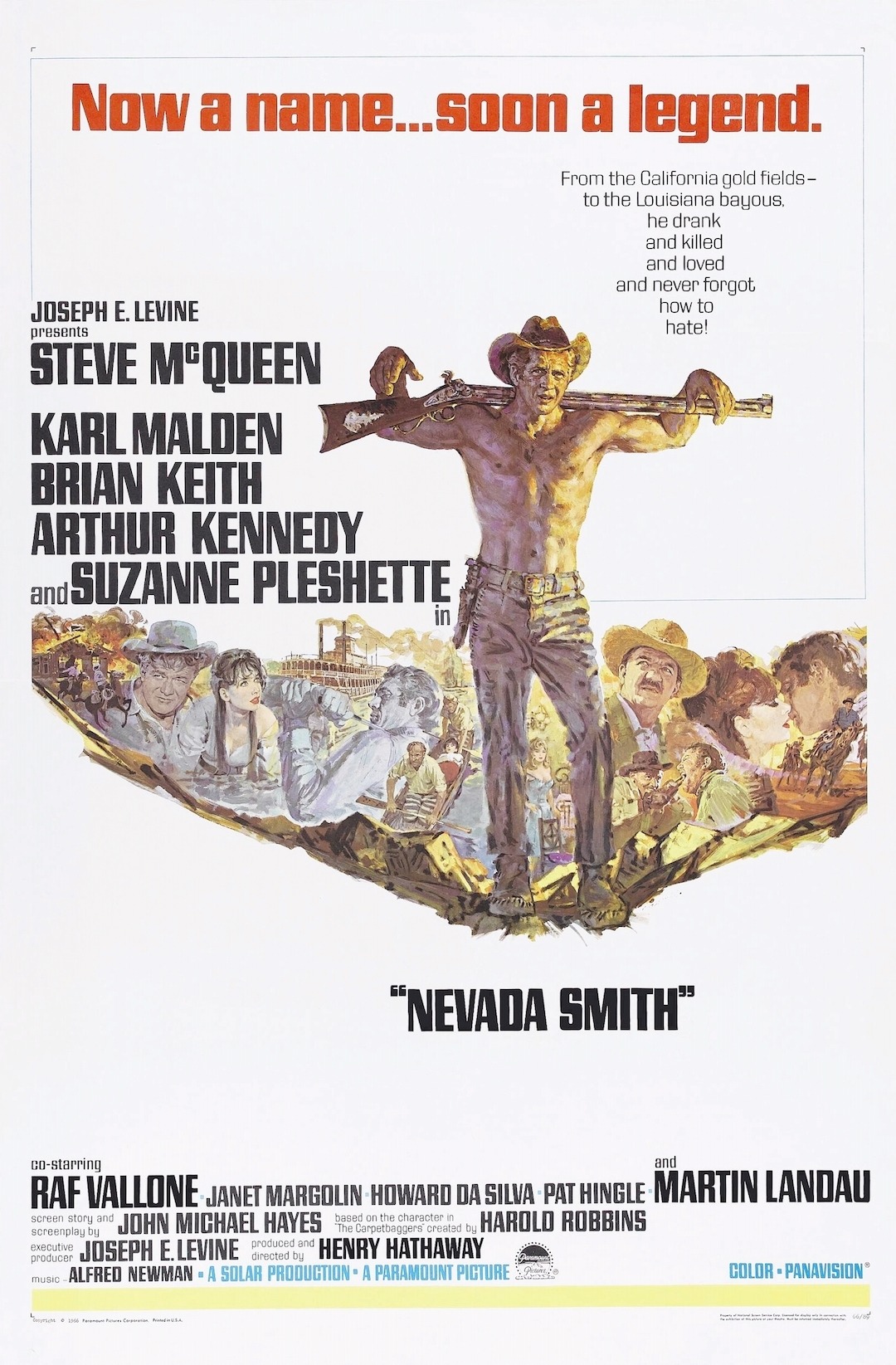 Nevada Smith (1966)
Nevada Smith (1966)
I do like a good revenge movie and this is one of the best. Until the end, that is, but I’ll get to that in a minute.
Steve McQueen, in top-notch cowboy form, plays the title role. It’s a prequel spin-off from an earlier movie, The Carpetbaggers, in which Nevada Smith was played by Alan Ladd, so consider this an early ‘origins’ film.
McQueen’s character is initially called Max Sand but I’ll refer to him as Nevada Smith from hereon in.
Smith’s parents are murdered by three outlaws, played by Martin Landau, Arthur Kennedy and Karl Malden.
Nevada vows to track them down and, after an interlude in which Brian Keith, playing a benign gunsmith, teaches him how to shoot, he tracks down his first victim, Landau.
I remember the ensuing knife-fight between the two of them because McQueen finishes Landau off by stabbing him multiple times in the stomach, finishing the murdering swine off like the dog he is.
Next up is Arthur Kennedy. Smith is so obsessed with revenge he goes to the inordinate lengths of getting himself banged up in the same prison as his quarry, before shooting him in the middle of a snake-filled swamp after they’ve escaped from the prison.
Now for Karl Malden or Mr. Potato Face as someone unkindly christened him.
There’s then another brief interlude, this time with Smith taken in by a priest who preaches against hate, revenge, death and all that other stuff that Jesus doesn’t like. Smith totally ignores him, thankfully, and resumes his hunt for Malden.
Karl Malden turns out not to be so easy to entrap, so Smith joins his gang, going undercover in order to catch him by stealth. This is the bit that slightly disappointed me when I saw it back in the 60s, because when McQueen finally gets the chance to kill Malden, he inexplicably lets him live, albeit after having pumped the murdering swine full of bullets.
The priest, of course, had something to do with Smith not wanting to finish Malden off, but you’re still left with the feeling that the audience has been short-changed in the revenge kill gratuitous violent manhunt stakes.
Seeing as this is directed by Western veteran director Henry Hathaway, who also co-directed The Carpetbaggers, the film is beautifully shot in a number of locations including the Eastern Sierra mountains.
The cinematography is courtesy of Lucien Ballard, a name associated with quite a few Westerns, who also worked frequently with Hathaway and Sam Peckinpah.
Upon reflection it’s also a bit of an ask to accept McQueen, who was in his mid-thirties at the time, playing someone nearly fifteen years younger than he was at the time.
No amount of slack-jawed scratching of the head by McQueen was ever going to fool an audience into thinking he was a young kid. Not only that but he’s also supposed to be of mixed parentage – I normally would have said ‘half-breed’ but apparently you’re not allowed to call somebody that these days – but someone forgot to tell the makeup department because he looks whiter than white to me.
I like Steve McQueen Westerns but there just aren’t that many of them, mainly because he sadly died too soon at the age of 50.
I recall I happened to be in Paris the day I heard he’d passed away. Someone put a photograph inside a shop window of McQueen sitting in a horse trough smoking a cigar, which I think was taken on the set of the Sam Peckinpah film Junior Bonner. Underneath it, they’d written ‘Au revoir Steve’. Au revoir indeed.
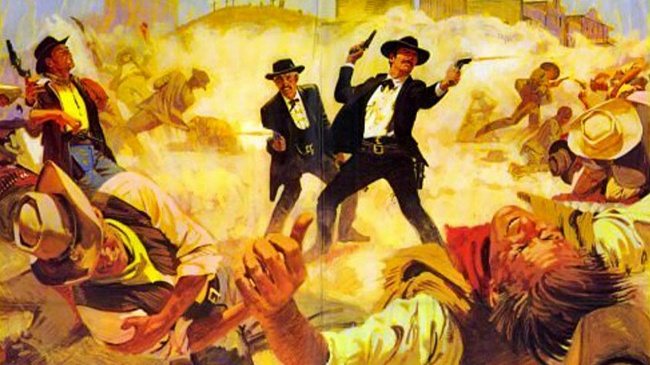 Hour of the Gun (1967)
Hour of the Gun (1967)
John Sturges directed this sequel to his earlier 1957 movie, Gunfight at the OK Corral, with James Garner and Jason Robards Jr. respectively taking on the roles of Wyatt Earp and Doc Holliday.
It follows the story in the aftermath of the showdown of the OK Corral, the film starting with the famous gunfight as a reminder of what happened. The earlier credits proclaim ‘This picture is based on fact. This is the way it happened’.
Ten years on from the earlier film, Sturges now has the freedom to adopt a more open attitude towards the depiction of violence in the old West, Garner’s interpretation of Earp rather more callous and menacing in tone than that of Burt Lancaster.
At one point, as they pursue Ike Clanton, played by Robert Ryan, and his gang of killers, Earp declares to Doc that he “doesn’t care about the rules anymore”. The film in effect charts the previously morally upright Earp’s descent into lawlessness, eventually disregarding due process of law. This is demonstrated when a ruthless Earp starts tricking his adversaries into shooting first, knowing he’ll always beat them to the draw.
The climax of the film is a tense showdown between Earp and Clanton. Earp takes off his badge, indicating he’s not going to go for all that ‘hands up and unbuckle your gun belt’ stuff. Earp shoots Clanton dead – which is factually incorrect thus negating the claim at the beginning of the film – but it brings matters to a satisfactory conclusion as far as the audience is concerned.
What I liked about this movie, watching it again over fifty years later, is that the story is not bogged down with all the troublesome female relationship stuff that made the overlong Kevin Costner / Lawrence Kasdan version of the same story so laborious to watch.
Sturges concentrates on two things: the relationship between Earp and Holliday, with Robards giving a great portrayal of Doc, and the war between Wyatt and Ike. In that respect it comes joint first with the later Tombstone, starring Kurt Russell as Wyatt Earp, in the OK Corral movie contest.
 The Scalphunters (1968)
The Scalphunters (1968)
I guess you’d categorise this movie as rollicking comedy-Western adventure, and as rollicking Westerns go this one’s not too bad.
What makes the film an interesting addition to the cowboy genre is the presence in the cast of African American actor Ossie Davis, as escaped slave Joseph Lee.
With the civil rights movement in America running at full gallop in the mid-sixties, it was only going to be a matter of time before Hollywood saw the wisdom of addressing the question of slavery full-on, albeit wrapped inside a comedy film in order to avoid upsetting the white section of the audience.
And Joseph Lee turns out to be more educated and refined than anyone else in the movie, so all the boxes are ticked from the first frame.
Although the lead character, Joe Bass, a wild hell-raising fur trapper, is played by Burt Lancaster, it’s a pre-Kojak Telly Savalas who nearly steals the film from both Lancaster and Shelly Winters, as scalphunter leader Jim Howie.
I say nearly because the whole film is actually hi-jacked by a horse that skids to a halt whenever anyone emits a high-pierced whistle, throwing its rider into the dust at every opportunity. Yep, it’s that kind of film.
The story starts with a band of Kiowas forcing a reluctant Burt to swap the pile of furs he’s spent all winter trapping in return for Ossie Davis.
From that point on Burt spends the rest of the film trying to retrieve his goods whilst battling the Kiowas, attempting to thwart a deadly band of scalphunters who do their best to kill him, as well as matching wits with the slave Joseph Lee. Whilst all this is going on, Lee plays Burt and Telly off against each other in order to avoid being sold back into slavery.
Burt’s constant harassment of Savalas and his band of killers in attempting to retrieve his furs is highly reminiscent of his role as resistance leader Labiche in the war film The Train, released a few years before.
Meanwhile, Shelley Winters and Savalas carry on like a married Jewish couple, which I guess is intentional seeing as Telly’s monicker in the film is Howie.
Just to complete the notion of married domesticity on the trail they travel in a bed on the back of a wagon. Upon Howie’s unfortunate accidental demise at the hand of Joseph Lee,
Shelley Winters nonchalantly throws her lot in with the chief of the Kiowa with the comment ‘What the hell, they’re still men’, which gives you some idea of the tone of the film.
It’s the kind of movie that these days would get a trigger warning on TV about racist content, what with the Kiowas referred to as ‘dirty redskins’ and Burt calling our Chinese brethren by a name you shouldn’t call them by anymore.
The message at the end is a bit too obvious, both Lancaster and Davis covered in mud to the point where you can’t tell them apart. Despite this, the worthiness factor stays mostly hidden beneath the boisterous veneer of the movie as a whole. A rousing score by Elmer Bernstein also helps to ensure the film is still an entertaining watch even after all these years.
I could have done without being exposed to Lancaster’s bare arse though.
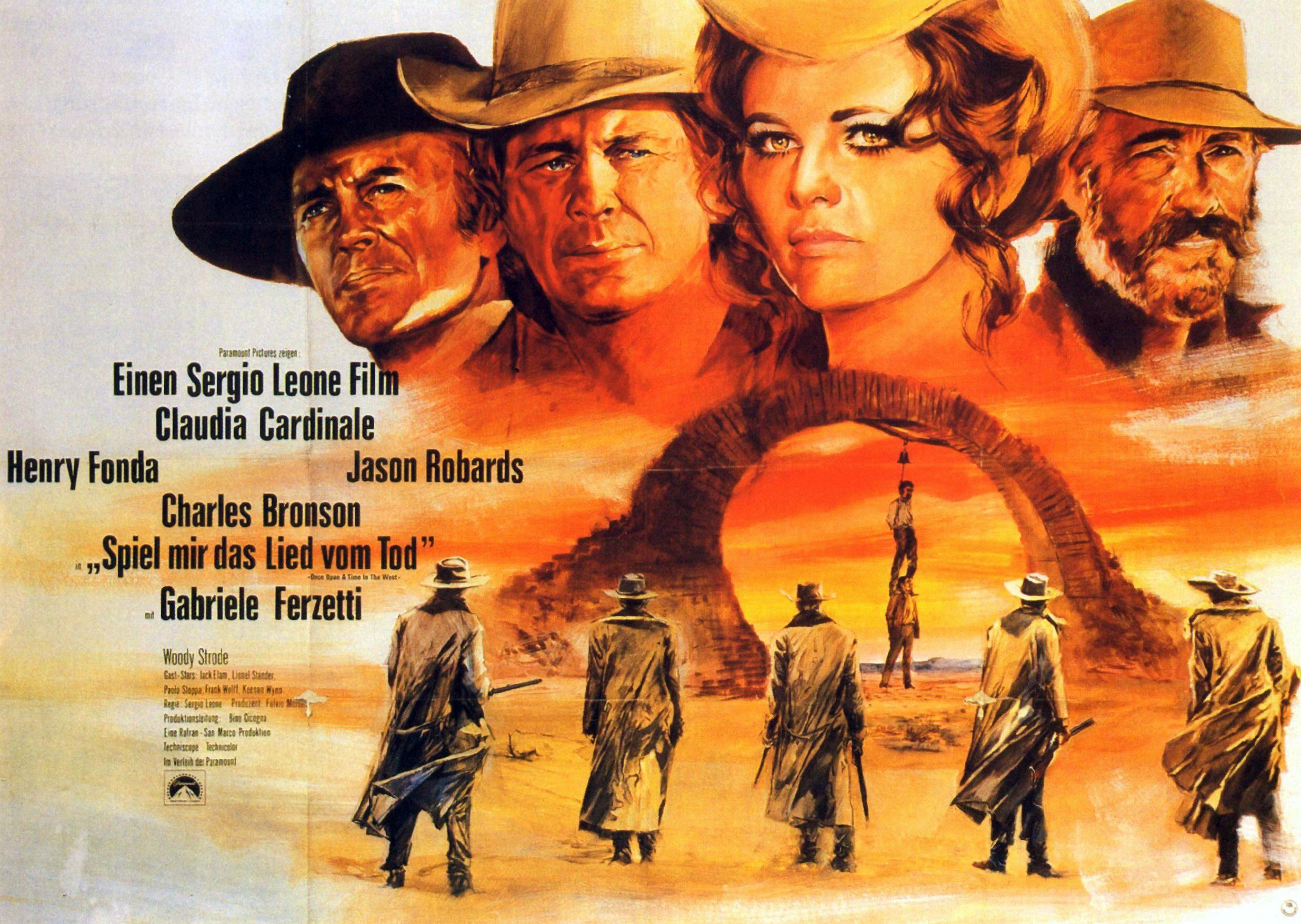 Once Upon A Time In The West (1969)
Once Upon A Time In The West (1969)
Before I begin I thought it best to come right out and say it. When I saw this movie for the first time back in 1969 I thought it was too slow and on a number of occasions just a tad boring.
I know that might be considered blasphemy by certain film scholars but I’m prepared to state that I consider director Sergio Leone’s masterpiece to be The Good the Bad and the Ugly, and not OUATITW.
Now that I’ve got that out of the way this film is rightly celebrated for the opening ten-minute sequence in which three gunmen, played by Woody Strode, Jack Elam and Al Mulock wait for a train to arrive in order to kill Charles Bronson.
It’s an extended riff on the same scene in High Noon in which Sheb Wooley, Lee Van Cleef and Robert J. Wilke wait for the arrival of Frank Miller, and is by far the best sequence in the film.
I read somewhere quite a long time back that Leone originally wanted the three gunmen, who all die at the hands of Bronson, to be played by Clint Eastwood, Eli Wallach and Lee Van Cleef, the protagonists from The Good the Bad and the Ugly, but apparently, Eastwood passed. A shame really. It would have made the scene even more memorable.
The other celebrated aspect of the film is the unexpected casting of Henry Fonda as a child-killing gunfighter.
The incongruity of an actor known for playing morally righteous characters such as Abraham Lincoln and Mister Roberts turning up as a murderous swine bereft of any redeeming qualities whatsoever turns audience expectations well and truly on its head.
Fonda even gets to kick away the crutches from under a crippled railroad magnate, although what with the guy being a rich fat-cat with his own private train and too much money to spend I guess he kind of deserved it.
The movie comprises a number of ‘guess the reference’ moments, with an obvious homage to The Searchers when Fonda and his gang turn up to slaughter a family, a cluster of birds erupting from the bushes just before the killing starts.
The cast is a mix of contemporary Hollywood faces – Charles Bronson, Jason Robards – and foreign character actors familiar from other Leone films.
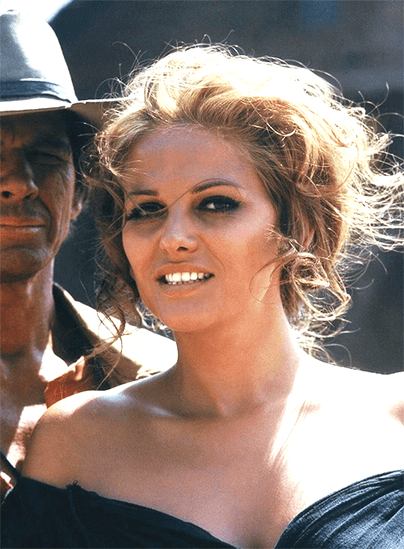 And then there’s Claudia Cardinale, who looks so astoundingly beautiful in the role of prostitute Jill McBain that words fail me.
And then there’s Claudia Cardinale, who looks so astoundingly beautiful in the role of prostitute Jill McBain that words fail me.
The scene in which a half-naked Claudia seduces Henry Fonda in return for her life had me hyperventilating like the lovelorn sexually frustrated pimply teenager I was back in 1969.
I find it quite ironic that, despite Leone having the gall to shoot some of the film in the hallowed John Ford country of Monument Valley, the landscape is trounced time and time again by the overwhelmingly spectacular shape of Claudia Cardinale’s curvaceous body.
I hesitate to try and map out the story because there appears to be a number of different versions of the film, and the one I viewed for this article had a couple of scenes that didn’t really make sense.
Even without that, the narrative is overly complicated but basically it’s the usual “he’s got the land that I want so he’s going to have to die” scenario with a few gunfights and a revenge story thrown in to move the story along.
It is still a memorable film but, apart from the casting against type of Henry Fonda, the opening sequence, a wonderful score by the ever-reliable Ennio Morricone and the presence of the lovely Claudia, I’m not sure it’s one I’d watch again in a hurry.
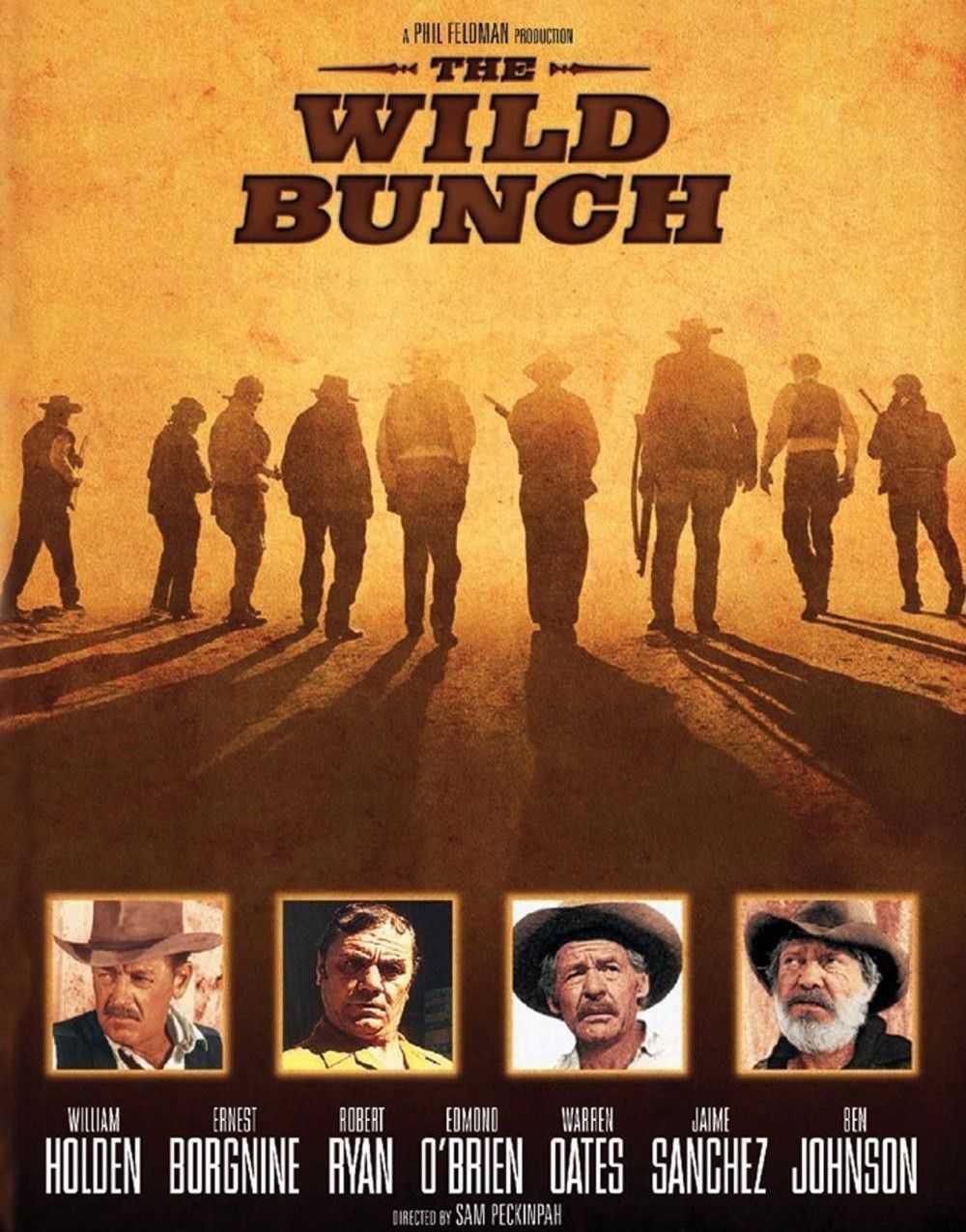 The Wild Bunch (1969)
The Wild Bunch (1969)
By sheer coincidence, the 10th film in this article also turns out to be my all-time favourite non-John Wayne Western, bar none.
I can still recall quite clearly watching this film for the first time on its release in the summer of 1969, sitting in the cinema slack-jawed in total astonishment, amazement, wonder and incredulity at the sheer wonder of the images thrown up on the screen.
I’d never seen anything like it before, and if I’d taken a moment to contemplate on the film afterwards I would have realised I’d probably never see anything like it again.
Apart from some aspects of Major Dundee, nothing in Peckinpah’s previous directing efforts gives any hint at all at what was to come when The Wild Bunch finally burst onto the screen.
It is without doubt the pinnacle of his career, a masterpiece in every sense of the word.
Any Western that followed in the footsteps of The Wild Bunch would forever be measured against a movie that not only challenged the rules of what could and could not be shown on the screen but finally set the seal on the ascent of the Hollywood maverick director. And Peckinpah was the biggest maverick of all.
If the overall theme of the movie is the passing of the West and ‘men out of their time’, then it was also a curtain call for a group of actors who between them had worked considerably within the Western genre over a number of years.
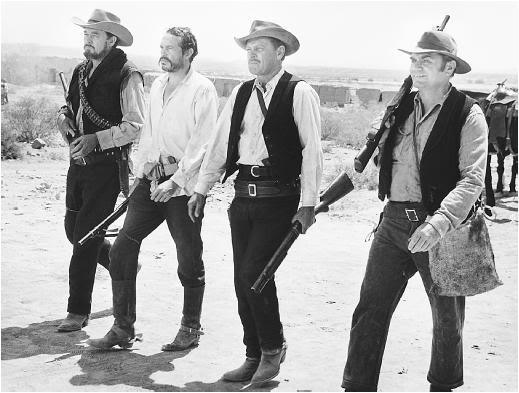 William Holden as gang leader Pike Bishop, Ernest Borgnine as Dutch, Ben Johnson as Tector Gorch, Edmond O’Brien and the underrated Robert Ryan give career-best performances, with the likes of Strother Martin, L.Q. Jones and Warren Oates as Lyle Gorch bolstering the cast.
William Holden as gang leader Pike Bishop, Ernest Borgnine as Dutch, Ben Johnson as Tector Gorch, Edmond O’Brien and the underrated Robert Ryan give career-best performances, with the likes of Strother Martin, L.Q. Jones and Warren Oates as Lyle Gorch bolstering the cast.
The movie is topped and tailed by two celebrated sequences of slow-motion bloodletting and orgiastic violence that has to be seen to be believed.
Even after nearly fifty years the film still manages to shock in its depiction of violent death and callous disregard for human life.
There’s a theory that this was all due to the influence at the time of the Vietnam War but that’s not an opinion I subscribe to.
The Wild Bunch is an invitation to view the world through the vision of a director not afraid to show what it looks like when a bullet pierces the flesh, when men turn on each other, when they are loyal to each other despite the consequences and the bloody result of those consequences shown in all its graphic horror.
There are so many brilliant moments and set pieces in this film that a short review such as this cannot do the film justice.
The scene, for instance, in which Ryan, as Deke Thornton, one-time gang member turned bounty hunter and his fellow posse members ride across a bridge primed with explosives that disintegrates beneath them is forever seared in the memory.
The moment prior to the climactic bloody shoot-out when the four remaining gang members, Pike, Dutch, Lyle and Tector decide to liberate Angel, their Mexican companion, from the clutches of Mapache, the corrupt Mexican general, the four of them marching in unison to a certain death accompanied by the clashing cymbals and drum beat of Jerry Fielding’s superb soundtrack.
I could go on but you really need to see this film for yourself in order to judge how superb The Wild Bunch is.
I’ve used the old cliché, “they don’t make films like this anymore” numerous times over the past few years when reviewing Western movies. Not only do they not make films like The Wild Bunch any more, but the fact is that sadly, in a world constrained by political correctness in which freedom of speech is constantly challenged and repressed, there’s no way in hell a film like this could be made today.
I severely doubt that the recently announced remake of The Wild Bunch by Mel Gibson will be anywhere near as good as the original.
In the final analysis, you either hate The Wild Bunch or you love it. For those of you who love it – we ride at dawn!
